Activity of the SNARE Protein SNAP29 at the Endoplasmic Reticulum and Golgi Apparatus
- PMID: 33718375
- PMCID: PMC7945952
- DOI: 10.3389/fcell.2021.637565
Activity of the SNARE Protein SNAP29 at the Endoplasmic Reticulum and Golgi Apparatus
Abstract
Snap29 is a conserved regulator of membrane fusion essential to complete autophagy and to support other cellular processes, including cell division. In humans, inactivating SNAP29 mutations causes CEDNIK syndrome, a rare multi-systemic disorder characterized by congenital neuro-cutaneous alterations. The fibroblasts of CEDNIK patients show alterations of the Golgi apparatus (GA). However, whether and how Snap29 acts at the GA is unclear. Here we investigate SNAP29 function at the GA and endoplasmic reticulum (ER). As part of the elongated structures in proximity to these membrane compartments, a pool of SNAP29 forms a complex with Syntaxin18, or with Syntaxin5, which we find is required to engage SEC22B-loaded vesicles. Consistent with this, in HeLa cells, in neuroepithelial stem cells, and in vivo, decreased SNAP29 activity alters GA architecture and reduces ER to GA trafficking. Our data reveal a new regulatory function of Snap29 in promoting secretory trafficking.
Keywords: Golgi apparatus; SEC22B; SNAP29 gene; SNARE protein; Syntaxin 5; endoplasmic reticulum; vesicle fusion.
Copyright © 2021 Morelli, Speranza, Pellegrino, Beznoussenko, Carminati, Garré, Mironov, Onorati and Vaccari.
Conflict of interest statement
The authors declare that the research was conducted in the absence of any commercial or financial relationships that could be construed as a potential conflict of interest.
Figures
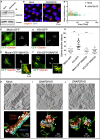
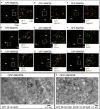
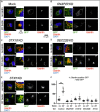
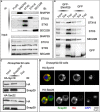

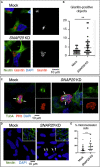

Similar articles
-
Multiple functions of the SNARE protein Snap29 in autophagy, endocytic, and exocytic trafficking during epithelial formation in Drosophila.Autophagy. 2014;10(12):2251-68. doi: 10.4161/15548627.2014.981913. Autophagy. 2014. PMID: 25551675 Free PMC article.
-
NEK3-mediated SNAP29 phosphorylation modulates its membrane association and SNARE fusion dependent processes.Biochem Biophys Res Commun. 2018 Mar 4;497(2):605-611. doi: 10.1016/j.bbrc.2018.02.116. Epub 2018 Feb 15. Biochem Biophys Res Commun. 2018. PMID: 29454964
-
A genetic model of CEDNIK syndrome in zebrafish highlights the role of the SNARE protein Snap29 in neuromotor and epidermal development.Sci Rep. 2019 Feb 4;9(1):1211. doi: 10.1038/s41598-018-37780-4. Sci Rep. 2019. PMID: 30718891 Free PMC article.
-
Snapshots from within the cell: Novel trafficking and non trafficking functions of Snap29 during tissue morphogenesis.Semin Cell Dev Biol. 2023 Jan 15;133:42-52. doi: 10.1016/j.semcdb.2022.02.024. Epub 2022 Mar 4. Semin Cell Dev Biol. 2023. PMID: 35256275 Review.
-
The function of SEC22B and its role in human diseases.Cytoskeleton (Hoboken). 2020 Aug;77(8):303-312. doi: 10.1002/cm.21628. Epub 2020 Aug 31. Cytoskeleton (Hoboken). 2020. PMID: 32748571 Review.
Cited by
-
Comparison of the Cisterna Maturation-Progression Model with the Kiss-and-Run Model of Intra-Golgi Transport: Role of Cisternal Pores and Cargo Domains.Int J Mol Sci. 2022 Mar 25;23(7):3590. doi: 10.3390/ijms23073590. Int J Mol Sci. 2022. PMID: 35408951 Free PMC article.
-
Alpha-Synuclein defects autophagy by impairing SNAP29-mediated autophagosome-lysosome fusion.Cell Death Dis. 2021 Sep 17;12(10):854. doi: 10.1038/s41419-021-04138-0. Cell Death Dis. 2021. PMID: 34535638 Free PMC article.
-
Syntaxin-5's flexibility in SNARE pairing supports Golgi functions.Traffic. 2023 Aug;24(8):355-379. doi: 10.1111/tra.12903. Epub 2023 Jun 21. Traffic. 2023. PMID: 37340984 Free PMC article.
-
Microcephaly-associated protein WDR62 shuttles from the Golgi apparatus to the spindle poles in human neural progenitors.Elife. 2023 Jun 5;12:e81716. doi: 10.7554/eLife.81716. Elife. 2023. PMID: 37272619 Free PMC article.
-
siRNA screening reveals that SNAP29 contributes to exosome release.Cell Mol Life Sci. 2023 Jun 7;80(7):177. doi: 10.1007/s00018-023-04822-8. Cell Mol Life Sci. 2023. PMID: 37285022 Free PMC article.
References
LinkOut - more resources
Full Text Sources
Other Literature Sources
Research Materials
Miscellaneous

